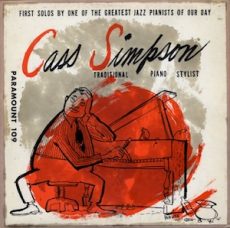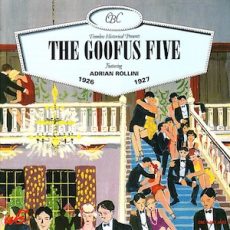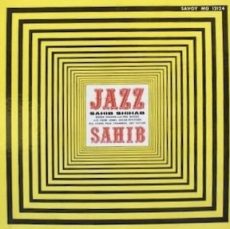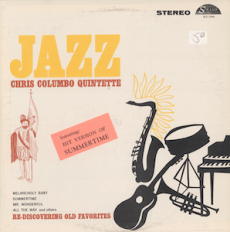
Daily Dose Of Jazz…
Wendell “Cassino” Simpson was born on July 22, 1909. He may have studied piano under Zinky Cohn. His first recording was in 1923 with Bernie Young, then recorded with the Moulin Rouge Orchestra in 1925. Following this he joined Arthur Sims’s orchestra, recording with them in 1926. With Sims dying soon after Bernie Young took over as bandleader and Simpson remained in the ensemble until 1930.
He simultaneously recorded with Jabbo Smith’s Rhythm Aces on his 1929 Brunswick Records releases. From 1931 to 1933 he played with Erskine Tate, though he never recorded with him. Cass recorded as a leader under various names, with Jabbo Smith and Milt Hinton as sidemen. In 1933 he cut a few sides with Half Pint Jaxon, a female impersonator.
Soon after his recordings with Jaxon, Simpson apparently became mentally disturbed, and was institutionalized in 1935 in Elgin, Illinois. While there, he continued to play piano and vibraphone in a hospital dance band, and played bass drum in the hospital’s marching band.
He recorded solo piano numbers on the grounds of the hospital in the middle of the 1940s. Pianist Cass Simpson, who was best known for his associations on the Chicago, Illinois jazz scene and was never released from the hospital, died on March 27, 1952.
More Posts: bandleader,history,instrumental,jazz,music,piano

Daily Dose Of Jazz…
Adrian Francis Rollini was born June 28, 1903 in New York City, New York of French and Swiss extraction. Growing up in Larchmont, New York, he showed musical ability early on and began to take piano lessons at the age of two. Considered a child prodigy, he played a fifteen-minute recital at the Waldorf Astoria Hotel at the age of four. By age 14 he was leading his group composed of neighborhood boys, in which he doubled on piano and xylophone.
Leaving high school in his third year he cut piano rolls for the Aeolian company on their Mel-O-Dee label and the Republic brand in Philadelphia, Pennsyolvania. At 16 he joined Arthur Hand’s California Ramblers and being equally skilled at piano, drums, xylophone, and bass saxophone, gained him Hand’s respect. Hand transferred the band to Rollini when he retired from the music field.
During the 1920s not only was he a member of the California Ramblers with Red Nichols, Jimmy and Tommy Dorsey, he also held membership in The Little Ramblers, The Goofus Five, and The Golden Gate Orchestra. During this time, he managed to lay down hundreds of sessions with Annette Hanshaw, Cliff Edwards, Joe Venuti, Miff Mole, Red Nichols, Bix Beiderbecke, Roger Wolfe Kahn, and Frank Trumbauer.
The 1930s saw him forming the Adrian Rollini Orchestra which recorded on Perfect, Vocalion, Melotone, Banner, and Romeo labels, where he played both bass saxophone and vibraphone. During the early swing era, starting in 1935, he managed Adrian’s Tap Room, owned the Whitby Grill, and opened White Way Musical Products, a store for the sale and repair of musical instruments.
Gradually shifting from the bass saxophone to the vibraphone after popularity of the hot jazz era of the 1920s waned. He went on to play hotels, arranging and writing songs behind the scenes. After an exhaustive career, he made his last recording with his trio in the early 1950s. He relocated to Florida, opened the Eden Roc Hotel in 1955, ran the Driftwood Inn at Tavernier Key and his Driftwood offered deep-sea fishing charters.
Bass saxophonist, pianist, and vibraphonist Adrian Rollini, died under unsolved circumstances on May 15, 1956 at the age of 52 in Homestead, Florida.
More Posts: bandleader,history,instrumental,jazz,music,piano,saxophone,vibraphone

Daily Dose Of Jazz…
Sahib Shihab was born Edmund Gregory on June 23, 1925 in Savannah, Georgia. Schooled in New York from age 3, he first played alto saxophone professionally for Luther Henderson at 13. He studied at the Boston Conservatory, and played in and around New York with Art Blakey, Gigi Gryce, Benny Golson, Thelonious Monk, Oscar Pettiford, Dizzy Gillespie. He toured with the bands of Fletcher Henderson, Buddy Johnson, Roy Eldridge, Andy Kirk, Duke Ellington, Count Basie and the original 17 Messengers of Blakey.
During the late 1940s, Shihab played with Thelonious Monk, and on July 23, 1951 he recorded with Monk that was later issued on the album Genius of Modern Music: Volume 2. During the decade he recorded with Art Blakey, Kenny Dorham and Benny Golson. The invitation to play with Dizzy Gillespie’s big band saw his switch to baritone saxophone.
Between 1952 to 1955 he toured with Illinois Jacquet in Europe, as well as with Coleman Hawkins and Sarah Vaughn and toured with Dakota Stanton from 1956 to 1958. He was one of the musicians who showed up for the Art Kane photograph A Great Day In Harlem. Closing out the Fifteies he toured Europe with Quincy Jones, and subsequently settled in Scandinavia in 1960, married and raising a family. Shihab, disillusioned with racial politics in the United States, decided around this time to move to Europe.
As an educator he worked for Copenhagen Polytechnic and wrote scores for television, cinema and theatre. He composed and arranged for Swedish and Danish radio orchestras. He went on to perform with bassist Niels-Henning Ørsted Pedersen and together with pianist Kenny Drew, he ran a publishing firm and record company. Through the Sixties he joined the Kenny Clarke/Francy Boland Big Band and remained a member of the band during its 12 years existence.
Returning to the United States in 1973 he toured with Quincy Jones and The Brothers Johnson. He returned to Copenhagen, Denmark three years later, where he produced albums for Metronome Records, along with Kenny Drew. The album is titled Brief Encounter, and features the voices of Debby Cameron and Richard Boone. At decade’s end he started a record company with Kenny Drew called Matrix and spent his remaining years between New York and Copenhagen, performed in partnership with Art Farmer and led his own jazz combo called Dues.
Hard bop baritone, alto, and soprano saxophonist and flautist, composer, arranger, producer and educator Sahib Shihab, who beginning of 1986 was a visiting artist at Rutgers University, died from cancer on October 24, 1989, in Nashville, Tennessee at age 64.
More Posts: arranger,bandleader,composer,educator,flute,history,instrumental,jazz,music,producer,saxophone

Daily Dose Of Jazz…
Joseph Christopher Columbus Morris was born on June 17, 1902 in Greeenville, North Carolina. He led his own band from the 1930s into the late 1940s, holding a residency at the Savoy Ballroom for a period. During the mid 1940s he began drumming behind Louis Jordan, remaining with him until 1952. In the mid-to-late 1950s, Columbo backed Wild Bill Davis’s organ combo, and he recorded with Duke Ellington in 1967.
He worked again as a leader in the 1970s, in addition to doing tours of Europe with Davis. While in France he played with Floyd Smith, Al Grey, Eddie “Cleanhead” Vinson, Buddy Tate, and Milt Buckner. He got his first professional gig playing with Fletcher Henderson in 1921. Between the 1920s and the 1960s, Columbo played at most of the city’s nightclubs, and led the Club Harlem Orchestra for 34 years until 1978, when the club shut its doors.
Columbo worked, recorded, and toured with prominent jazz artists including Dizzy Gillespie, Louis Armstrong and Ella Fitzgerald. He did an album on the Strand label called Jazz: Re-Discovering Old Favorites by the Chris Columbo Quintette featuring organist Johnny “Hammond” Smith. He appeared in the 1945 film It Happened In Harlem, based on the Harlem nightclub Smalls Paradise and the 1947 film Look Out Sister.
Prior to suffering a stroke in 1993 which partially paralyzed, Columbo was the oldest working musician in Atlantic City. Chris’ band went on to perform at practically every Atlantic City casino hotel. At the time of his stroke, he was playing regularly at the Showboat.
Drummer Chris Columbo, who was a father figure to Sonny Payne, who was also known as Crazy Chris Columbo and sometimes credited as Joe Morris on record, died on August 20, 2002 in New Jersey. He was 100 years old.
More Posts: bandleader,drums,history,instrumental,jazz,music

Daily Dose Of Jazz…
Alfred Viola was born on June 16, 1919 in Brooklyn, New York and grew up in an Italian family. He learned to play the guitar and mandolin as a teenager. Enlisting in the Army during World War II and played in an Army jazz band from 1942 to 1945.
He started a trio with pianist Page Cavanaugh and bassist Lloyd Pratt. The band appeared in several films, including Romance on the High Seas with Doris Day, and played a few dates in 1946 and 1947 with Frank Sinatra. Viola continued to work with Sinatra regularly, accompanying him on several hundred studio recordings and concert dates between 1956 and 1980.
Viola was a session musician in Los Angeles, California performing in films and television. His mandolin playing can be heard on the soundtrack of The Godfather. Other credits include West Side Story and Who’s Afraid of Virginia Woolf? He continued playing jazz as well, with Bobby Troup, Ray Anthony, Harry James, Buddy Collette, Stan Kenton, Gerald Wilson and Terry Gibbs.
He worked as a session musician on over 500 albums, including releases by Natalie Cole, Neil Diamond, Marvin Gaye, Julie London, Steve Lawrence, Linda Ronstadt, Jimmy Witherspoon, Helen Humes, June Christy, Ella Fitzgerald, Anita O’Day, Nelson Riddle, and Joe Williams.
Viola and Cavanaugh reunited in the 1980s with Phil Mallory and continued to play regularly in Los Angeles until the late 1990s.
Guitarist Al Viola, recorded ten albums as a leader, died of cancer on February 21, 2007 at the age of 87 in Los Angeles.
More Posts: bandleader,guitar,history,instrumental,music



